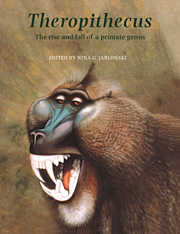Book contents
- Frontmatter
- Contents
- List of Contributors
- Preface
- Acknowledgements
- 1 Introduction
- PART I Fossil evidence and phylogeny
- PART II Biogeography and evolutionary biology
- PART III Anatomy of the fossil and living species of Theropithecus
- 10 Allometric aspects of skull morphology in Theropithecus
- 11 Evolution of the masticatory apparatus in Theropithecus
- 12 Dental microwear and diet in extant and extinct Theropithecus: preliminary analyses
- 13 The development and microstructure of the dentition of Theropithecus
- 14 Postcranial anatomy of extant and extinct species of Theropithecus
- PART IV Behaviour and ecology of living and fossil species of Theropithecus
- Appendix I A partial catalogue of fossil remains of Theropithecus
- Appendix II Conservation status of the gelada
- Index
12 - Dental microwear and diet in extant and extinct Theropithecus: preliminary analyses
Published online by Cambridge University Press: 11 November 2009
- Frontmatter
- Contents
- List of Contributors
- Preface
- Acknowledgements
- 1 Introduction
- PART I Fossil evidence and phylogeny
- PART II Biogeography and evolutionary biology
- PART III Anatomy of the fossil and living species of Theropithecus
- 10 Allometric aspects of skull morphology in Theropithecus
- 11 Evolution of the masticatory apparatus in Theropithecus
- 12 Dental microwear and diet in extant and extinct Theropithecus: preliminary analyses
- 13 The development and microstructure of the dentition of Theropithecus
- 14 Postcranial anatomy of extant and extinct species of Theropithecus
- PART IV Behaviour and ecology of living and fossil species of Theropithecus
- Appendix I A partial catalogue of fossil remains of Theropithecus
- Appendix II Conservation status of the gelada
- Index
Summary
Summary
Recent work has shown that microscopic wear patterns on teeth can yield insights into diet and dental function in a variety of mammals. The purpose of this study was to see if (a) distinctive dental microwear patterns could be documented for museum samples of modern Theropithecus, and (b) similar patterns might be discernible on the teeth of fossil baboons from the Omo deposits in Ethiopia.
Epoxy casts were prepared from dental impressions as described by Rose (1983) and Teaford & Oyen (1989a). Scanning electron micrographs were taken of the second mandibular molars at a magnification of 500 times. Computations and analyses were the same as those described by Teaford & Robinson (1989).
Results indicate that there are significant differences in dental microwear between Theropithecus gelada and T. brumpti. There are also significant differences between T. brumpti and T. oswaldi, whereas the latter is generally more similar to T. gelada in terms of its dental microwear patterns.
The molars of T. gelada are characterized by the presence of enamel prism relief and relatively little microwear. Microwear features that are present tend to be fine scratches and occasional large pits. The molars of T. brumpti are characterized by the presence of more microwear and more pits than in either T. oswaldi or T. gelada. Theropithecus oswaldi differs from T. gelada in the higher percentage of pits and smaller size of the pits on its molars.
These data suggest that T. brumpti and T. oswaldi had different diets.
[…]
Information
- Type
- Chapter
- Information
- TheropithecusThe Rise and Fall of a Primate Genus, pp. 331 - 350Publisher: Cambridge University PressPrint publication year: 1993
Accessibility standard: Unknown
Why this information is here
This section outlines the accessibility features of this content - including support for screen readers, full keyboard navigation and high-contrast display options. This may not be relevant for you.Accessibility Information
- 35
- Cited by
